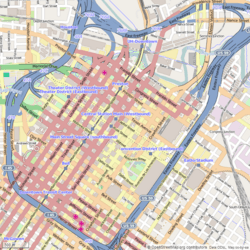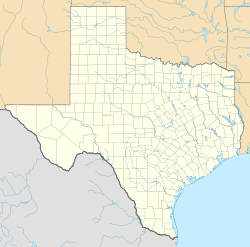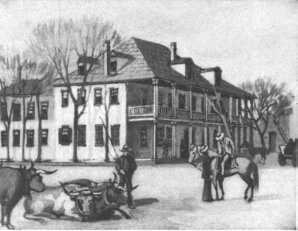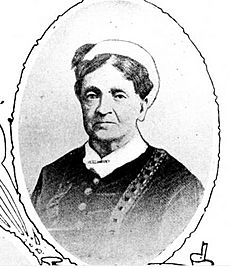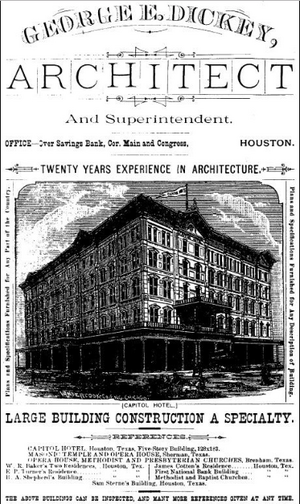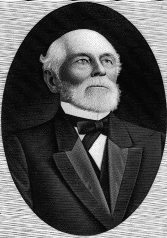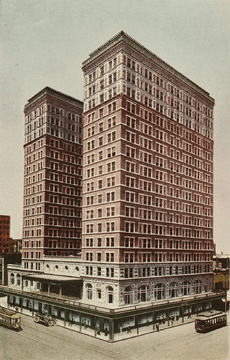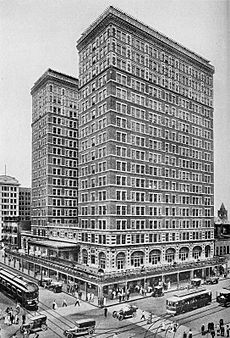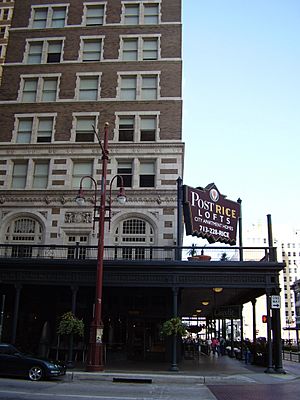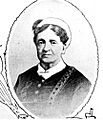The Rice (Houston) facts for kids
Quick facts for kids |
|
|
The Rice
(Rice Hotel) |
|
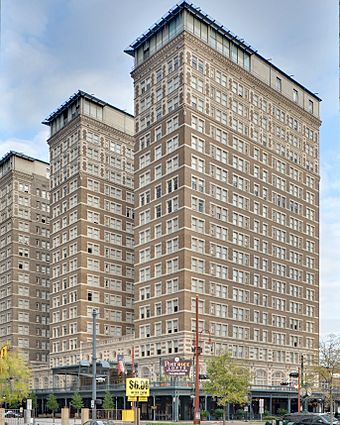
The Rice, seen in 2010
|
|
| Location | 909 Texas Avenue @ Main Street Houston, Texas United States |
|---|---|
| Built | 1913 |
| Architect | Mauran, Russell & Crowell; Alfred C. Finn, and J. Russ Baty |
| NRHP reference No. | 78002947 |
| Added to NRHP | June 23, 1978 |
The Rice, also known as the Rice Hotel, is a famous building in Downtown Houston, Texas, United States. It stands at 909 Texas Avenue. This building is actually the third one to be built on this important spot. It was finished in 1913.
The land where The Rice stands was once home to the Capitol building of the Republic of Texas. The current building is listed on the National Register of Historic Places, which means it's an important historical site. The original Capitol building was used as a hotel before it was taken down. A new hotel was built around 1881. Later, in 1913, a businessman named Jesse H. Jones built the seventeen-story "Rice Hotel." This building grew over the years, adding more sections and floors. It was a hotel until 1977. After being empty for 21 years, The Rice was updated into apartments and reopened in 1998 as the Post Rice Lofts. It was sold in 2014 and is now simply called The Rice.
Contents
The First Capitol Building: Texas History Starts Here
When Augustus Chapman Allen and John Kirby Allen planned the city of Houston in 1836, they set aside land for the government of the Republic of Texas. They chose a spot on Texas Avenue. They also agreed to build a capitol building for the Texas government. They rented it to the government for a very low price.
The Republic of Texas used this building as its capitol from 1837 to 1839, and again from 1842 to 1845. In 1841, a man named Mr. M. Norwood rented the building and ran it as the Capitol Hotel. After the Texas government left Houston, Augustus Allen continued to rent the building to different hotel managers. Charlotte Allen, Augustus's wife, sold the property in 1857. The hotel had a few different names, like Houston House and Barnes House, until 1881.
The First Rice Hotel: A New Beginning
In 1881, Abraham Groesbeck tore down the original building. He then built a new five-story hotel in the Victorian style. This building was known as the Capitol Hotel. It was designed by George E. Dickey, a famous architect.
William Marsh Rice bought the hotel after Groesbeck passed away in 1886. Rice added a three-story section to the building. After Rice died in 1900, the hotel property went to the Rice Institute, which he had started in 1891. The people in charge of the Rice Institute then renamed it the Rice Hotel.
Jessie H. Jones, who would later build the current Rice Hotel, lived in this first Rice Hotel when he first came to Houston around 1898. Texas Governor James Hogg also lived there in 1904.
The Second Rice Hotel: A Grand New Building
The old Rice Hotel was losing money and its taxes were not paid. Jesse H. Jones offered to lease the land from the Rice Institute. He planned to replace the old hotel with a new one through his company, the Houston Hotel Association. Jones signed a 99-year lease, with an option to extend it for another 99 years. The Rice Institute also helped Jones by investing money from its funds to build the new hotel.
After tearing down the first Rice Hotel in 1912, Jones hired Mauran, Russell & Crowell to design the new building. The new seventeen-story hotel, shaped like a "C" or "U", opened in May 1913. It had four restaurants, a large banquet room, a small concert hall, and a rooftop area. Building it cost about $3.5 million.
Improvements and Famous Guests at The Rice Hotel
Even though the new Rice Hotel lost money at first, the Houston Hotel Association was able to pay back its loans. Jesse Jones kept making the building better. In 1922, he put air-conditioning in the Rice Hotel Cafeteria. This was the first public room in Houston to have air-conditioning! In 1924, he made the cafeteria bigger. In 1925, Jones hired Alfred C. Finn to design a new section for the hotel. This made the hotel have over 1,000 rooms and gave it its current "E" shape.
The Crystal Ballroom got air-conditioning in 1928. This was the same year Houston hosted the National Democratic Convention. Jones helped bring the convention to Houston by donating $200,000. A famous guest during the convention was Franklin D. Roosevelt, who later became President. Jones even built a large temporary shelter on the hotel roof for the convention. This rooftop area became a popular place for dancing in the 1930s.
Jones continued to invest in the Rice Hotel through the 1930s. He opened a barber shop in 1930, which stayed open until 1977. In 1938, the lower floors were remodeled, and a new dining area called the Empire Room was added. In 1940, the cafeteria was changed into the Skyline Room. In 1946, the Rice Hotel was the first in Houston to install an escalator. By 1949, all the guest rooms had air-conditioning. In 1951, the roof deck was turned into an eighteenth floor to house the Petroleum Club of Houston.
After Jones passed away in 1956, the Rice Hotel building was given to the Jones family's non-profit, the Houston Endowment. The hotel continued to operate under their management until 1971. In 1958, a five-story addition was built for a motor lobby and a second grand ballroom. The hotel had fancy dining in the Flag Room, a casual coffee shop, and the underground Rice Hotel Cafeteria, famous for its rice pudding. It also had many shops, like a news stand and a jewelry store.
In 1962, the Rice Hotel was used for a meeting of NASA Astronaut Group 2, also known as "The New Nine." These astronauts, who were training for space missions, all checked in using the code name "Max Peck." This event was shown in the 1998 HBO miniseries From the Earth to the Moon.
U.S. President John F. Kennedy visited the Rice Hotel on September 12, 1962, after his famous speech, "We choose to go to the moon." He also visited on November 21, 1963, before traveling to Fort Worth and then Dallas, where he was tragically assassinated. Kennedy used a suite at the Rice Hotel for meetings. He also gave a famous speech about religion in politics there in 1960. Other important speakers at the Rice included Texas Governor William P. Hobby and Captain James A. Baker.
Other famous guests at the Rice Hotel included Groucho Marx and Liberace. Many well-known musicians performed there, such as Tommy Dorsey, Perry Como, Xavier Cugat, Woody Herman, Lawrence Welk, and a young Illinois Jacquet.
Changes in Ownership and Closure
Rice University took over ownership of the Rice Hotel through a gift from the Houston Endowment. The university already owned the land since 1900. The hotel was making money for a few years. However, Rice University estimated that following a new 1974 Houston fire code would cost a lot of money, about $1.2 million. In December 1974, the university said they might tear down the hotel if they couldn't sell it.
Rittenhouse Capital Corporation bought the property in 1975. It briefly reopened as the Rice-Rittenhouse in April 1976 after some remodeling. But the hotel closed again in August 1977.
After the 1977 closure, several groups tried to buy and save the Rice Hotel. The Rice Preservation Corporation bought it at an auction in September 1977. Portfolio Management of Texas bought it in early 1978 for $3 million. The new owners got the building listed on the National Register of Historic Places. They also planned to use federal money to turn the building into apartments. However, they couldn't raise enough money. In 1981, Rovi Texas Corporation bought the property for $7.75 million. They announced plans to make it a luxury hotel, but their plan relied on federal help that didn't come through. Eventually, a German bank, Frankfurt BFG-Bank AG, took ownership.
Restoring The Rice: From Hotel to Lofts
Randall Davis became interested in redeveloping the Rice Hotel in 1995. He was known for fixing up old buildings and turning them into loft apartments. Some of his past projects included the Dakota Lofts and the Hogg Palace.
Michael Stevens, who led the Houston Housing Finance Corporation (HHFC), suggested a plan where public and private groups would work together. This plan included $5 million from Randall Davis's group and $5 million from the City of Houston. But as the cost of the renovation went up, the private investors pulled out.
Stevens then came up with a new plan using a special funding method called "tax increment financing" (TIF). This meant the Rice project would borrow money based on future increases in tax revenue. The City of Houston created a special zone for this. Based on expected tax money, Stevens got a $6 million loan from Wells Fargo Bank. Stevens, through HHFC, also committed another $8 million to the project.
Stevens later sold most of the city's share in the hotel to Columbus Properties for $4.5 million. Columbus (later renamed Post Properties) also took on all the city's debt for the project. The city kept ownership of the land, while Davis got a 40-year lease.
Davis hired the architectural firm Page Southerland Page to plan the renovation. They decided to restore the public areas to look like the 1913 Rice Hotel. This included bringing back the two-story lobby, the Crystal Ballroom, and the Empire Room. The ground floor also had 25,000 square feet of space for shops.
The Rice Lofts: A New Life for a Historic Building
Post Properties (formerly Columbus Properties) opened the Post Rice Lofts for residents in April 1998. The building, which once had 1,000 hotel rooms, was transformed into 312 apartments. These included smaller "efficiency" apartments, larger 1,500-square-foot apartments, and even some three-story penthouses.
Sambuca, a jazz club, opened on the ground floor of the Post Rice Lofts in October 1998. It was still operating there in 2014.
In early 2014, Post Properties put the Post Rice Lofts up for sale. They said that 95% of the apartments were rented, and the average rent was $1,700 per month. Later that year, a company called CH Realty/MF Houston Rice VI bought the building from Post Properties and renamed it simply The Rice.
In 2014, the new owners, Crow Holding Capital Partners, announced plans for more renovations. They planned to update the appliances and remodel each apartment's kitchen and bathroom. They also planned to move the swimming pool and fitness center from the basement to the second floor. Valet service was also offered to residents.
Who Lives and Works There?
The Petroleum Club of Houston, started in 1946, was originally located on the top floor of the Rice Hotel. It moved to the ExxonMobil Building in 1963.
The Rice Lofts is part of the Houston Independent School District. Students living there go to Crockett Elementary School, Gregory Lincoln Education Center for middle school, and Northside High School (which used to be called Davis High).
Images for kids


